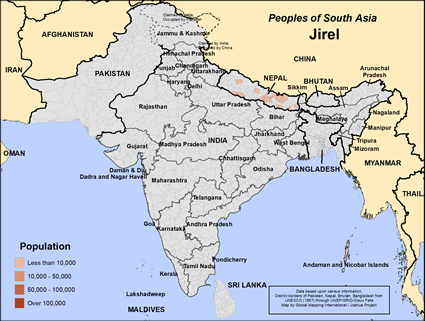Jirel in Nepal

Photo Source:
Anonymous
|

Map Source:
People Group Location: Omid. Other geography / data: GMI. Map Design: Joshua Project
|
| People Name: | Jirel |
| Country: | Nepal |
| 10/40 Window: | Yes |
| Population: | 5,900 |
| World Population: | 5,900 |
| Primary Language: | Jirel |
| Primary Religion: | Buddhism |
| Christian Adherents: | 4.38 % |
| Evangelicals: | 0.00 % |
| Scripture: | New Testament |
| Ministry Resources: | Yes |
| Jesus Film: | No |
| Audio Recordings: | Yes |
| People Cluster: | South Asia Buddhist |
| Affinity Bloc: | South Asian Peoples |
| Progress Level: |
|
Introduction / History
This is a minority nationality having unique manners and customs. They call themselves Jiripa. The Jirels of eastern Nepal are both ethnically and linguistically related to both the Sherpas and Sunuwars. The language of Jirels is of Tibeto-Burman family. Jirels are the aboriginal inhabitants of Jiri and Jugu area of the Dolkha District. Their population is centered on the Jiri Valley. They believe that their origin arose because of trade between this region and the adjoining regions in Tibet.
What Are Their Lives Like?
Little is known about them, but their cultural affinities with Sunwars and Sherpas suggest that their culture is a form of the Bhoti culture. Their main form of subsistence is agro-pastoral production, combining the cultivation of wheat, barley, and maize, with the herding of goats and cattle. The newborn is christened on the third or seventh day of its birth by Lama or Jhakris (a kind of shamans). The cereal-feeding ceremony is held for son and daughter in the seventh or third month respectively. Their marriages are officiated by Jhakris and Lamas. Since Saturday and Monday are considered inauspicious for marriage ceremonies, they prefer other days of the week. The couple marries by consent. When the marriage procession reaches the house of the girl's parents the girl's side and the boy's side exchange a holy water pot. The marriage becomes complete when the boy and the girl drink local beer from the same vessel. Marriage within the same clan is not permitted. The corpse of the dead is washed cleanly and dressed in new clothes before burial. Some are cremated in the night of death. People dance the whole night while someone plays a small drum. At death ceremonies, a Buddhist tradition prevails. However, for many domestic ceremonies they call a Brahmin priest and adhere to the bramanical tradition. This strange mixture can be explained by their mixed ethnic origins. Jirels have 10 clans. If a Jirel marries a woman from another tribe, he should ask for forgiveness from members of his own tribe and should feed them by organizing a feast. The level of education among Jirels is very low.
What Are Their Beliefs?
The Jirels practice Tibetan Buddhism and have their own lamas. There is a Sherpa Buddhist monastery and a Jirel monastery in the valley. Like other ethnic groups, the Jirel's religious beliefs include elements derived from Hinduism, as well as shamanistic practices. Jirel shamanistic practices are similar to their activities elsewhere in eastern Nepal. They worship the Bhote god in Chaitra and Mangsir so that the god of rivers does not cause any illnesses.
What Are Their Needs?
The Jirel people need to submit to Jesus Christ so they can experience the abundant life He offers them in John 10:10.
Prayer Points
Pray that the Jirel people will have a spiritual hunger that will open their hearts to the King of kings. Pray for workers who are driven by the love and boldness of the Holy Spirit to go to them. Pray for a Disciple Making Movement among them to begin this decade.